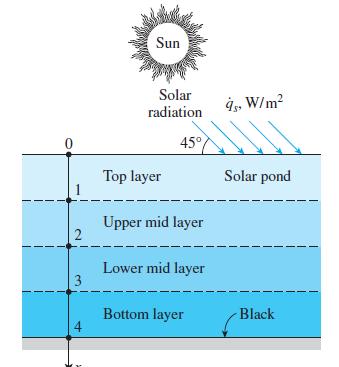Solar radiation incident on a large body of clean water (k = 0.61 W/m K and
Question:
Solar radiation incident on a large body of clean water (k = 0.61 W/m · K and α = 0.15 × 10-6 m2/s) such as a lake, a river, or a pond is mostly absorbed by water, and the amount of absorption varies with depth. For solar radiation incident at a 45° angle on a 1-m-deep large pond whose bottom surface is black (zero reflectivity), for example, 2.8 percent of the solar energy is reflected back to the atmosphere, 37.9 percent is absorbed by the bottom surface, and the remaining 59.3 percent is absorbed by the water body. If the pond is considered to be four layers of equal thickness (0.25 m in this case), it can be shown that 47.3 percent of the incident solar energy is absorbed by the top layer, 6.1 percent by the upper mid layer, 3.6 percent by the lower mid layer, and 2.4 percent by the bottom layer [for more information see Çengel and Özi¸sik, Solar Energy, 33, no. 6 (1984), pp. 581–591]. The radiation absorbed by the water can be treated conveniently as heat generation in the heat transfer analysis of the pond. Consider a large 1-m-deep pond that is initially at a uniform temperature of 15°C throughout. Solar energy is incident on the pond surface at 45° at an average rate of 500 W/m2 for a period of 4 h. Assuming no convection currents in the water and using the explicit finite difference method with a mesh size of Δx = 0.25 m and a time step of Δt = 15 min, determine the temperature distribution in the pond under the most favorable conditions (i.e., no heat losses from the top or bottom surfaces of the pond). The solar energy absorbed by the bottom surface of the pond can be treated as a heat flux to the water at that surface in this case.
Step by Step Answer:

Heat And Mass Transfer Fundamentals And Applications
ISBN: 9780073398181
5th Edition
Authors: Yunus Cengel, Afshin Ghajar





